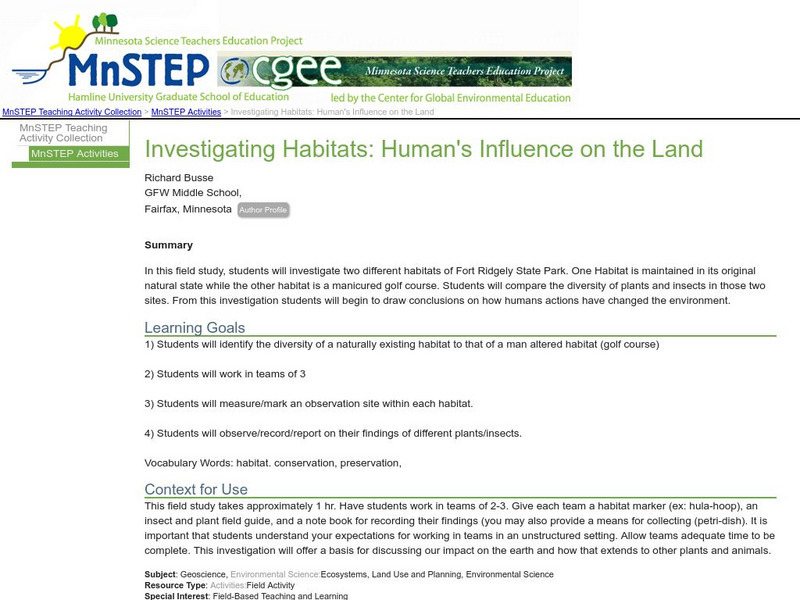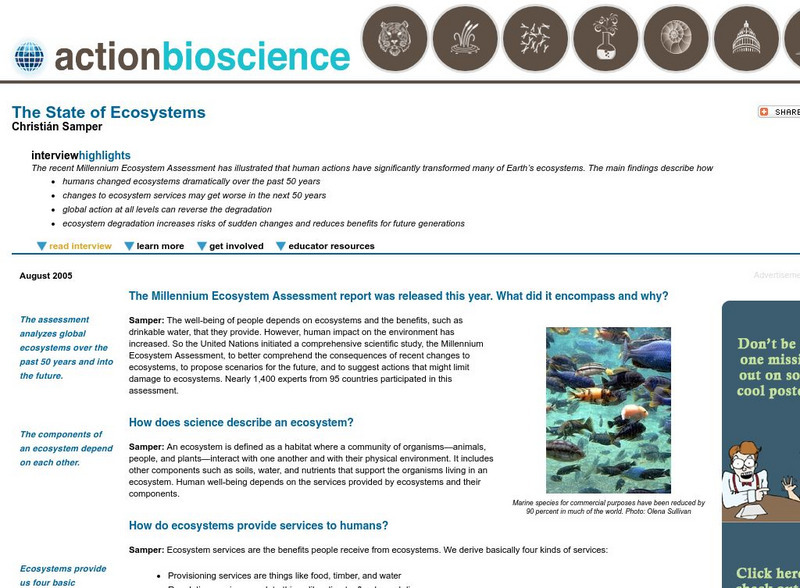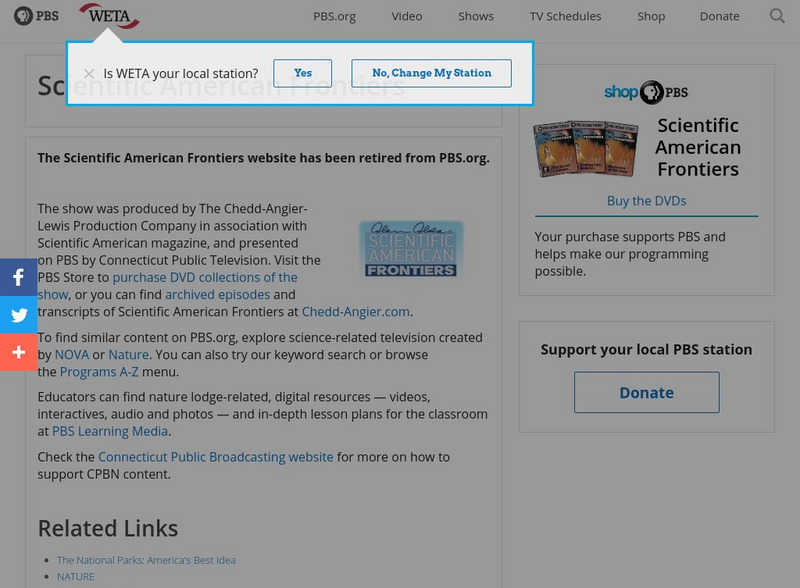Hi, what do you want to do?
Science Education Resource Center at Carleton College
Serc: Investigating Habitats: Human's Influence on the Land
Students will investigate two different habitats; one habitat is maintained in its original natural state while the other habitat is a manicured golf course. Students will identify and compare the diversity of plants and insects in those...
TeachEngineering
Teach Engineering: The Other Water Cycle
For students that have already been introduced to the water cycle, this lesson is intended as a logical follow-up. Students will learn about human impacts on the water cycle that create a pathway for pollutants beginning with urban...
Smithsonian Institution
National Museum of Natural History: Does Our Background Shape Our Thinking About Environmental Issues? [Pdf]
A lesson where young scholars explore the positive and negative impacts of human activities on the environment today and in the distant past, and examine how attitudes towards the environment might be shaped by one's experiences growing...
Other
Skidmore College: Lifestyle Project
A copy of an article published in the Journal of Geoscience Education. It describes how the Lifestyle Project got started, and how it is used with students to help them develop an awareness of how their daily habits and actions have an...
Yale University
Yale Environment 360: The Oil Spill's Growing Toll on the Sea Life of the Gulf
Marine biologist Thomas Shirley explains the impact of the Gulf of Mexico oil spill in the short and long term. The total impact is hard to determine at this point of time, however. Shirley gives his best opinion of the damage that...
Center for Educational Technologies
Cet: Exploring the Environment: Human Health Effects
As an epidemiologist on the U.S. Panel for Climate Change, students are tasked with analyzing the latest data on climate-impacted human health conditions. A solid understanding of the mechanisms underlying the connections will allow for...
Other
Alaska Sea Grant: Investigation 4 Human Impact Survey
Students examine and record data about the impact human activity has on a local aquatic environment in this teaching unit. They then analyze the information and develop a plan for improvement. The unit depends on being able to take the...
National Center for Ecological Analysis and Synthesis, University of California Santa Barbara
University of California: A Global Map of Human Impacts to Marine Ecosystems
Maps in different categories such as fishing, climate change, and pollution were pulled together into a composite map that shows the impact of humans on the world's oceans. Analysis at the time (2008) showed that 40% of the world's...
PBS
Pbs: Pov Borders: Environment
Point of View is television's longest running showcase for independent non-fiction films. This particular feature provides insight regarding alternative means of energy, transport, and the consumption of natural resources. Video, games,...
PBS
Pbs: Journey to Planet Earth: On the Brink
A part of the PBS series "Journey to Planet Earth," this section examines "how severe environmental problems can lead to political crises and increased hostilities around the world." Includes video clips and educational resources.
Population Connection
Population Connection: Population and Environment[pdf]
A paper from the Population Connection that outlines the consequences to the environment if humans continue on the path of overpopulation.
The Wonder of Science
The Wonder of Science: K Ess3 3: Environmental Solutions
This NSTA vetted source includes resources to teach ideas on reducing the impact of humans on the environment. Included are assessment ideas, videos, examples, lesson plans, and photos of student work.
Other
Fuel Our Future Now: Gr. 6 8 Module: Designing a Vehicle for the Year 2020 [Pdf]
In this 6-8 teaching module, students learn about natural resources, human impact on the environment, and engineering design in vehicle transportation. Using real world scientific data and scientific reasoning skills, they investigate...
Science Education Resource Center at Carleton College
Serc: Mn Step: Animal Game Impact of Human Activity or Natural Disasters
A description of a lesson where students first listen to a story where they begin to think about and discuss the impact humans and natural disasters have on the environment. They then play a board game. This requires preparation...
Texas Education Agency
Texas Gateway: Organisms and Environments: Humans and Ocean Systems
This tutorial overviews the ocean ecosystem and human's impact on it.
Other
Baltimore Co. Public Schools: Chesapeake Bay Food Webs (Online Research Model)
Food webs lesson, which focuses on Chesapeake Bay habitats, integrates biological concepts with literacy knowledge and skills. Lesson directs students to answer the question, how does a human-caused stress placed on the environment...
Texas A&M University
Ocean World: The Dust Bowl and Aftermath
Description of the Dust Bowl from a geological and climatological perspective and the human impact on these processes. Includes maps, photos, references, and links to related material.
American Institute of Biological Sciences
Action Bioscience: The State of Ecosystems
Christian Samper details The Millennium Ecosystem Assessment, a report highlighting the detrimental impact of human life on the ecosystems of Earth over the past fifty years. Ecosystems have been deteriorating from a variety of waste and...
TeachEngineering
Teach Engineering: Product Development and the Environment
In this activity, students investigate the life cycle of an engineered product and how the product impacts the environment. They analyze a product using a simple life cycle assessment that assigns fictional numerical values for different...
TED Talks
Ted: Ted Ed: The Survival of the Sea Turtle
Video describes the struggle of infant sea turtles as they deal with hazards and predators in their environment. [4:26] Includes a short quiz and a list of additional resources to explore.
Center for Innovation in Engineering and Science Education, Stevens Institute of Technology
Ciese: Carbon Imbalance: Algae to the Rescue? [Pdf]
A 95-page learning module that integrates biology, chemistry, and engineering. It includes in-class labs, virtual labs, and engineering design activities. Working with algae, students learn about and investigate how photosynthesis,...
National Humanities Center
National Humanities Center: Teacher Serve: History With Fire in Its Eye: An Introduction to Fire in America
This site from the National Humanities Center provides an interesting look at the history of fire in America, how we use it to control natural resources and how it controls us.
PBS
Pbs Teachers: Scientific American: The Frontiers Decade: Environment Decade
Investigate man's impact on the environment. Observe different species to see how sensitive they are to human presence, and record your observations in a field notes log.
The Newberry Library
Newberry: Environmental History: Map 7: Distribution of Woodland in u.s., 1873
Lesson plans for K-12 using maps that show the distribution of wooded land in 1873. Students examine the impact of humans on the environment.







![National Museum of Natural History: Does Our Background Shape Our Thinking About Environmental Issues? [Pdf] Lesson Plan National Museum of Natural History: Does Our Background Shape Our Thinking About Environmental Issues? [Pdf] Lesson Plan](https://static.lp.lexp.cloud/images/attachment_defaults/resource/large/FPO-knovation.png)












![Ciese: Carbon Imbalance: Algae to the Rescue? [Pdf] Unit Plan Ciese: Carbon Imbalance: Algae to the Rescue? [Pdf] Unit Plan](http://lessonplanet.com/content/resources/thumbnails/455842/large/bwluav9tywdpy2symdizmdeyny0xmdcynjyylwcwy3uxni5qcgc.jpg?1674855345)


